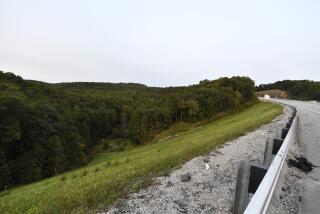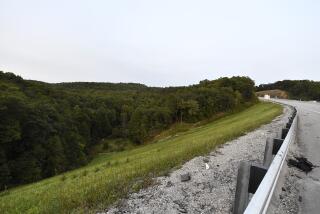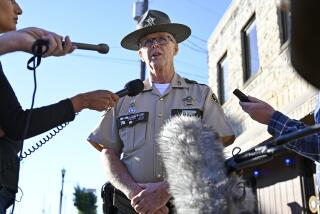Clues Emerge in Sniper Probe
ROCKVILLE, Md. -- Police investigating the Beltway serial murder spree pursued a wealth of new witness reports Tuesday and eyed a growing list of “individuals of interest” as authorities confirmed that the unseen killer had gunned down one of their own.
Several witnesses who heard the single rifle shot that killed FBI analyst Linda Franklin in a Falls Church, Va., shopping mall Monday night were able to recount partial numbers from the plates of a white van seen near the crime scene, officials said. Police were also reportedly working on their first sketch of a possible suspect -- a graphic of a dark-skinned man sighted inside a white van.
But one task force official cautioned that while police had “more people in the area this time making observations” than at previous shooting sites, the latest accounts do not yet amount to a break in the case. “How he’s doing it and what his methods are, we still don’t know,” the official said.
The U.S. military also was drawn into the hunt for the killer. A Pentagon official said Defense Secretary Donald H. Rumsfeld approved an FBI request Tuesday to use military surveillance planes to sweep the Washington metropolitan area, capturing video images that could help track the sniper on the road.
Authorities said they had no evidence suggesting that the rifle-toting killer might have purposely targeted Franklin, 47, because of her civilian FBI job as a researcher analyzing terrorist threats. But FBI officials were hit hard by the revelation that the sniper had slain a four-year employee and mother of two.
Gary M. Bald, the FBI special agent coordinating the bureau’s team in the sniper probe, said federal agents were airlifted to the shooting scene “within minutes” Monday night after learning Franklin’s identity.
“She did an exceptional job for us and we’re going to miss her,” Bald said. Another FBI official said Franklin’s co-workers at FBI headquarters in downtown Washington were devastated: “It’s just [one] more nail in the wall that makes us want to do whatever we can to catch this guy.”
The circumstances of Franklin’s slaying amounted to a grim repetition of the sniper’s brazen pattern. Like eight other victims in the last two weeks, she was killed from a distance by a single .223-caliber gunshot as she was going about her daily business -- in her case, loading packages with her husband in the parking lot of a Home Depot.
Witnesses were unable to provide any solid firsthand accounts of Franklin’s slaying, the task force official said. The lack of eyewitness evidence has hampered police repeatedly over the two weeks that the gunman has crisscrossed the Washington area, killing nine people and seriously wounding two.
“The crime scene is distant,” the official said. Witnesses “are not near where the shooting occurred, and when they look up, the first thing they pick up is vehicles driving away.”
But investigators said the aftermath of Franklin’s slaying offered some strands of hope.
There were more witnesses than at any other shooting scene, the official said. Some offered a flurry of new details -- including partial tag numbers of vehicles leaving the scene. And at least one witness reportedly provided a description of a dark-skinned occupant of a white van.
Prompted by a similar earlier report, and after the sniper’s 10th shooting on Friday, police briefly detained a Georgia man who said detectives referred to a video scan of a similarly dark-skinned man as they interrogated him.
But Montgomery County, Md., Police Chief Charles A. Moose, who is leading the police task force, warned that police were far from ready to issue a sketch of any suspect.
“We’d love to come forth and show you the mug shots of the person suspected,” Moose said. But he said police feared that prematurely releasing vague information could “contaminate” the effort to catch the suspect or suspects.
“If we have information we feel needs to be placed in the public arena, we will do that,” Moose said.
Fairfax County, Va., Police Chief Tom Manger said: “There was some additional information that we were able to get from [Monday] night’s case, and I am confident that information is going to lead to an arrest.”
But Manger declined to verify a report that a witness had reported several numbers from a Maryland plate on one van. “We are not ready to release any tag information,” Manger said.
On Monday night, police sent out a bulletin on a white van seen driving off from the Home Depot lot. Witnesses said the vehicle had a ladder rack and a burned-out left taillight. A similar vehicle was reported in the vicinity of a sniper slaying near Fredericksburg, Va., last week, and police released a composite graphic of that van on Tuesday.
“We want to use this to jog people’s memories,” Moose said.
Teams of detectives have also been investigating the backgrounds of a list of “between five and 20” individuals whose names have surfaced from tips and records checks over the two-week probe.
The task force official described the list as “fluid,” shrinking and growing as names are dropped and others are added. Investigators culled many of the names from tips that have poured in by the hundreds each day. Others were prompted by methodical scans through firearm registries, motor vehicle listings and arrest records. All of the subjects, the official said, are undergoing intensive investigations.
“Some of these people we’ve eliminated from suspicion pretty quickly,” he said. “There are others whose names stick around. They’re the ones we’re obviously interested in.”
Even as the detective teams continued that basic investigative work, federal officials drew in military officials to lend high-tech support to the search for the sniper. Pentagon officials already had mined the service records of military marksmen, trying to weed out any who might have shown signs of mental instability aligned with that of serial killers. The search, requested by the police task force, had found nothing substantial, officials said.
On Tuesday, Rumsfeld agreed to a second FBI request to borrow military aircraft to track the sniper from the air. Military experts said there were several aircraft that might be well-suited for such a mission, including Army RC-7 reconnaissance planes, and Navy P-3 Orion aircraft.
The propeller-driven craft are equipped with telescopic cameras able to capture detailed images of vehicles or other subjects from altitudes of 20,000 to 30,000 feet, said John Pike, an analyst at Globalsecurity.org.
“As soon as you get a report of a shooting, they would train a camera on the location and start panning around in an expanding circle,” Pike said.
Both types of aircraft have been used extensively in drug surveillance operations, and may already be equipped with radios operating on police frequencies, Pike said. He added that the planes’ lenses are unable to penetrate cloud cover.
In agreeing to the FBI request, Pentagon officials took care not to order military personnel operating the planes to work directly for the task force. Pilots and other military officials would answer to orders from their own superiors and only turn over the information they had received to the task force. That relationship is being tailored carefully so that it poses no violation of a 19th century legislative prohibition against the armed forces’ engaging in domestic law enforcement.
Despite all its latest high-tech weaponry, the task force’s burgeoning assets have helped little in the moments after the killer strikes.
Minutes after Franklin was shot dead near her car on Monday night, scores of Virginia State Police and local officers shut down sections of Washington’s Beltway in an attempt to snare the killer.
But the sniper’s timing has been impeccable. Investigators concede that he is likely already on the move by the time witnesses react to the sound of the high-powered rifle blast, then provide their accounts to investigators. And by the time police arrive and summon reinforcements, the killer may already be miles down the highway or disappearing on a lightly traveled side road.
“We can only do what we can at the time,” said Cpl. Rob Moroney, a Maryland State Police official and spokesman for the task force. “We’d rip out our hair thinking what could have been.”
About 10 minutes after Franklin was shot down, an army of police departments surged out to the highways, backing up traffic for miles. Police turned sections of Interstates 95, 66 and 495, and other roads, into nighttime parking lots, trying to block the shooter from escaping into Maryland or the District of Columbia, just six miles away.
“We tried to make sure that if the vehicle was on the George Washington Parkway, we would find it,” said Sgt. Scott Fear, a spokesman for the U.S. Park Police, one of many law enforcement agencies taking part in the extraordinary dragnet.
Some observers said local Virginia police lost precious minutes taking control of the roads near the shooting. The 911 call about a shooting came into the Fairfax County Police Department at 9:19 p.m. About 10 minutes passed before police issued a bulletin with a description of a light-colored van with a left rear taillight burned out. The suspect van was last seen heading east on U.S. 50, a major artery connecting the Virginia suburbs to Washington.
Not until 9:30 p.m. did Virginia State Police shut down ramps and portions of the major interstates around the Home Depot. All bridges leading out of Virginia were closed. Lighting the ground with searing white rays, two Maryland state police helicopters and one from Virginia patrolled the area around the Home Depot.
“We had troopers on almost every ramp checking vehicles and working with the county police, doing everything we could at their request,” said Virginia State Police spokeswoman Lucy Caldwell.
But if the white van continued east on U.S. 50, the road it was last seen on, “10 minutes after the shooting, you could be into D.C.,” conceded Arlington Police public information officer Matt Martin.
Adriana Velasquez, 35, who lives across the road from the Home Depot, heard the rifle blast Monday night, but by the time she reached her window, there was no white van.
“We knew right away what it was,” she said, recalling the gun’s echo. “You can’t mistake it.”
At midday Monday, the Velasquez family crossed U.S. 50 and made their way to the spot where Franklin fell the night before.
They held votive candles and white flowers in their fists. They lighted the wicks, and feeble light quivered in the dim garage.
“It hurts us that somebody would kill a stranger for no reason at all,” Velasquez said. “It isn’t right. We’re all one flesh.”
*
Times staff writers Lisa Getter, Josh Meyer and Megan K. Stack contributed to this report.
More to Read
Sign up for Essential California
The most important California stories and recommendations in your inbox every morning.
You may occasionally receive promotional content from the Los Angeles Times.










